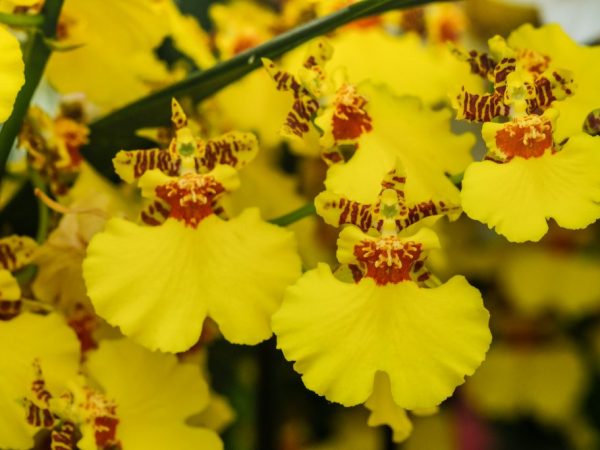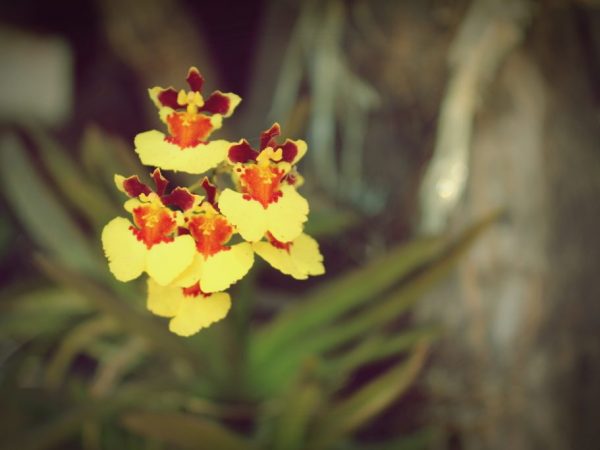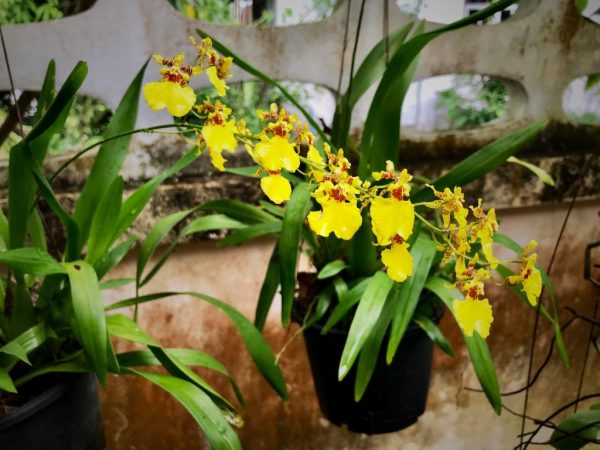Growing an orchid oncidium
One of the most popular and best-selling flowers is the oncidium orchid. This plant is diverse in its types. Caring for the oncidium orchid at home for all varieties should be regular, timely and thorough.

Growing an orchid oncidium
Description of the Orchid Oncidium
Representatives of this plant grow in the humid and warm forests of Central America, as well as its southern regions. Some species love moisture, while others, on the contrary, love hot weather and sunlight. Some grow in the mountains, others in the lowlands or hills. That is why you should choose your own, special care for each type of oncidium orchid.
To date, more than 700 species of these orchids are known. These are Zygopetalum, Dendrobium, Dendrofalenopsis, Cambria, Fantasy Music, Black (Black) orchid, Oncidium Twinkle, vanilla (variegated species) and many other varieties. From its habitual habitat to Europe, oncidium came only in the 18th century. And today he is a permanent resident of apartments and houses.
Oncidiums love light more than other varieties and they are most resistant to temperature extremes. In its care, the plant is unpretentious, which is why flower growers love it so much. With proper care, it blooms every 9-12 months, and the oncidium orchid will practically not be exposed to diseases and insect pests.
As for the appearance, it is difficult to confuse this view with others. The peculiarity of this type of orchid is the unusual shape of the lower lip, which looks like a skirt. From the slightest breath of wind, the flower begins to sway.
Common types
Popular varieties of oncidium, which are most often grown at home. They are loved for their unpretentiousness, their ability to withstand daily temperature drops.
- Yellow oncidium is perhaps the most popular and well-known species. Such popularity was brought to him by his unpretentious care. They recognize this variety by its small yellow flowers.
- Sweet sugar - the flower of this type of orchid consists, as it were, of two parts. Flowers in diameter reach from 3-5 cm.The length of the peduncle itself is no more than 40 cm.
- Orchid Twinkle or Twinkle is perhaps the smallest variety. The size of the flowers themselves reaches up to 2 cm. They grow well and bloom in a moderate temperature regime, even despite the fact that at night the temperature should be 4-5 ° lower than daytime. They do not require constant watering of the soil, they tolerate transplantation well.
- Mike van Holm. This variety is easily recognized by its tall, branched peduncle. There are many small, fragrant flowers on it. Most often they are yellow or red. This variety has several thickened pseudobulbs, from which long narrow leaves extend. Transplant perfectly.
- Red Fantasy is a hybrid variety of oncidium that tolerates a wide temperature range: from 10 to 25 °. If the air temperature is higher, then the orchid stops growing.For this variety, it is important that the temperature difference does not reach more than 3-4 ° during the day.
- Curved. This variety has long roots. Pseudobulbs are flattened, separated from each other. From each of them, one leaf grows, reaching 20-25 cm in length. The inflorescence itself is loose, and the flowers are miniature. Most often, the shade is yellow with red dots.
- Tiger. This variety has oval pseudobulbs, with 2-3 leaves. The flowers of the tiger oncidium are large and reach a diameter of 7-8 centimeters. The flowers themselves are yellow with dark brown spots.
- Curly oncidium. This orchid loves space, so it will not be easy for it to get along with other flowers. The petals of curly chocolate-colored oncidium have wavy edges. Cut flowers last more than two weeks, all this time they retain their natural aroma.
- Popcorn. Miniature orchid variety. She is completely unpretentious in care. The size of the flowers reaches about 1.5-2 cm. The color is white. Popcorn oncidium reaches a height of about 15 cm.
Each of the varieties has its own pros and cons. What variety will grow in your apartment or house - it's up to you. But when buying a flower, do not forget to familiarize yourself with the features of caring for a plant at home and evaluate your strengths and capabilities in this matter.
Care features

Taking care of a flower is not difficult
Caring for the oncidium orchid at home does not require any specific knowledge in the field of gardening or floriculture. The state of the plant as a whole can be judged by the leaves, which are in a healthy flower of a juicy green hue, and by the airy and non-dry roots of the flower. If you follow the simple rules of care, then the oncidium orchid will delight you for a long time and at the same time bloom beautifully once a year or more often.
Lighting
Caring for an orchid of absolutely any variety at home requires good lighting, since this plant especially loves light. She prefers bright lighting. It should be placed in the shade only during the midday heat, when the sun shines especially strongly and brightly. The larger and fleshy the plant, the more light it needs.
To determine if a flower is getting enough light, look at the leaves. If they have taken on a dark green hue, then this indicates a lack of light. If the leaves, on the contrary, have become light or covered with red or even black spots, or the leaf turns yellow, then this indicates too much illumination. Only setting the correct level of illumination will allow you to reanimate the flower. In good light, the leaf should be juicy, green, without any dots and spots. Lighting is especially important when forming pseudobulbs. If this process occurs in the winter, then in this case additional illumination with a lamp will be needed.
Temperature
All oncidiums are divided into three groups:
- The flowers are thermophilic, which grow in the tropics, with hot temperatures, sometimes drought. For them, the optimal daytime temperature will fluctuate from 28 to 30 °, at night the temperature reaches from 16 to 19 °. The daily temperature difference should not exceed 5 °.
- Flowers that require and love moderate temperatures. For example, this is tiger oncidium. For them, the optimal daytime temperature in summer should reach no more than 23 °. In winter, it can be slightly lower - about 13-15 ° C.
- The species that love the cold. They usually grow in mountainous, shady forests where there is high humidity. The temperature range in which they feel comfortable is wide - from 15 to 25 °. However, despite this, for this group of orchids, it is important that the daily temperature difference does not exceed 2-3 °.
Orchids that grow in apartments are hybrid varieties. They feel good in a wide temperature range - from 15 to 26 °. If the temperature is higher, the plant stops growing roots, which means that the oncidium will not bloom.For good growth and favorable condition, the required temperature should be maintained, while not allowing it to jump or fall. It is in such cases that you can make a transplant without causing any damage to it.
Air humidity
With the help of aerial roots, the flower receives moisture and nutrition from the air, therefore it suffers from insufficient air humidity. Indoor conditions for this flower are favorable. It is important that the humidity is around 50-60%. Spraying is necessary only in summer, hot weather, or during the heating season. If the room temperature reaches less than 17 °, then there is no need to spray the plant at all.
It is also important to remember that in any room you should observe not only air humidity, but also ventilation. Fresh air is always important for a plant, especially one such as oncidium.
Watering and flowering

The plant needs regular watering
Watering and flowering in oncidium care are closely related. To achieve and get flowering, at least once a year, you need to water regularly. This should be done from the beginning of growth, right up to the process of forming a pseudobulb.
Watering rules:
- It is imperative to ensure that the soil has time to dry out between waterings. You can determine if the next watering is necessary by the weight of the pot. At the same time, you should not wait for the earth to be too dry and begin to crack, as this also has a detrimental effect on the growth and flowering of the plant.
- You should not adhere to a specific schedule for watering oncidium, because the rate of soil drying depends on many factors. If it's summer outside, then the soil will dry out many times faster. In winter, this process takes a little longer.
- When forming a pseudobulb, it is required to abruptly cancel watering, only in this case the orchid will bloom. Somewhere in about 21-28 days from the new growing pseudobulb, a peduncle should go. When you are convinced that this is it, resume the process of regular watering.
When the flower has already faded, the watering procedure should be slightly shortened, since the plant does not need too much moisture for this period. With proper watering, oncidium blooms approximately every 9-12 months, in some varieties - a little more often.
Top dressing and fertilization
Top dressing is required for the plant only during the growth of young shoots. During the formation of pseudobulbs, no additional fertilizing is required. When the peduncle begins to develop and the flowering process begins, feeding should be resumed again.
It is important that the dressing is not too concentrated, since the roots of this plant are sensitive to all kinds of drugs and substances. Therefore, it is better to do fertilizers diluted, feeding should be done through the leaves. The recommended dose should be 9-10 less than what is indicated on the package.
Reproduction of oncidium
At home, the reproduction process is carried out only in a vegetative way. It is worth starting to divide the curtain only when more than 6 pseudobulbs are tied on the flower. Only in this case will the delenki be viable.
The division procedure is carried out with a sharp knife. For this, an underground stem is cut. After that, the place where the incision was made must be sprinkled with coal. It is important to observe one more prerequisite: when carrying out the division process, the earth must be absolutely dry. Also, after the procedure, the plant cannot be watered for about 10 days, which will allow the wound to dry out.
You can carry out reproduction with the help of a baby - a shoot that has its own root system. However, this phenomenon is rare in practice, and if you have an offspring on your orchid, this is more the exception than the rule.
Protection against diseases and pests
It should be remembered that any purchased flower needs a month's quarantine.
As practice shows, in most cases, oncidium is affected by mealybugs. It will be difficult not to notice it, it resembles pieces of cotton wool, which can be either on the ground or on the plant itself. If you notice something like this, then moisten a cotton pad with water, remove the white lumps, and then wipe all areas with alcohol. Do not forget to treat the flower with Aktara.
If you find small blotches that resemble droplets of wax, then most likely it is a scabbard. If a cobweb appears on the sheets, it means that a tick has appeared on the plant. In the fight against a pest, you should remove everything with a cotton pad, treat with an alcohol solution. If possible, treat with a special solution to prevent further development of the disease. At an advanced stage of the lesion, remove the plants from the pot, remove the damaged parts on the roots, sprinkle with charcoal and transplant into a new substrate.
Often, orchids are attacked by bacteria and fungal rot. The damaged area usually takes on a brown tint. For example, this is typical for leaves. The first thing to do is to remove the damaged leaves. Next, you need to ensure good ventilation in the room, and also make sure that the earth dries out between waterings. It will not be superfluous to carry out treatment with fungicides, as well as antibiotics. You can get them at any gardening store.
Conclusion
Caring for this amazing flower will be easy if you provide it with regular watering, feeding and protection from diseases and pests. In gratitude for this, he will delight you with his decorative and graceful look all year round.


